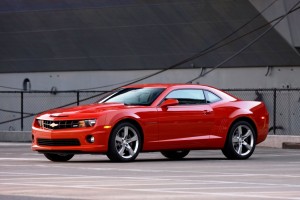It looks like engineers at General Motors have caught Ford napping once again as the 2011 Camaro DOHC V6 engine is now rated at 312 horsepower at 6500 rpm, and 278 lb-ft of torque at 5100 rpm. That’s a lucky seven horsepower more than Mustangs brand new V6.
Camaro fuel economy numbers haven’t been released yet, but last year the GM V6 delivered 304 horsepower and 273 lb.-ft. of torque, and returned up to 29 mpg on the highway, but only 17 mpg in the city. (Click Here for First Look: 2010 Camaro Synergy Special Edition )
“The 304 horsepower in the 2010 Camaro was actually a conservative rating on our end,” said Tom Sutter, GM V-6 chief engineer. “But we knew already that this award-winning engine produced at least the amount of power we stated, but now we’ve gone the extra step in certifying the engine for this application and have verified an additional eight horsepower.”
The GM 3.6-liter V6 continues its use of variable valve timing (VVT). Its direct injection system uses four independent cam phasers to change the timing of valve operation as conditions such as rpm, and engine load vary. The result is linear delivery of torque, with near-peak levels over a broad rpm range, and high specific output or maximum horsepower per liter of displacement.
The DOHC 3.7-liter Mustang produces 305 horsepower at 6,500 rpm and 280 ft.-lb. of torque at 4,250 rpm. The Ford V6 is EPA rated at 19 mpg city and 31 highway with the six-speed automatic transmission, up from 16 mpg city and 24 highway on the 2010 model with automatic.
(The badly outclassed 2010 Dodge Challenger SOHC 3.5-liter V6 is rated at 250 horsepower at 6,400 rpm and 250 lb.-ft. of torque at 3,800 rpm.)
That certainly gives the Camaro bragging rights, but it may or may not be enough to outrun the lighter Mustang. Here, the calibration of the traction control systems will very much be in play.
Moreover, there is an element of absurdity about the whole horsepower race, since electronic chassis and traction control systems at both makers will likely curb maximum engine output under most conditions to maintain stability.
Last year the GM V6 delivered 304 horsepower and 273 lb.-ft. of torque, and returned up to 29 mpg on the highway, but only 17 mpg in the city. (Click Here.)
The output numbers are based on a voluntary Society of Automotive Engineers (SAE) power and torque certification procedure. This procedure (J2723) ensures accurate ratings for horsepower and torque by allowing manufacturers to certify their engines through third-party witness testing. Chevrolet was the first vehicle brand to begin using the procedure. Not surprisingly makers in the past have been know to enhance the output of their performance engines via press releases and advertising rather then through actual thermal efficiency.
Since its introduction last year, the Camaro has out sold the Mustang, the original pony car, for 10 straight months through March 2010, even though it was production constrained. See Camaro Kicks Mustang’s Derriere. Again! GM’s Oshawa, Canada, Assembly Plant has been running Saturday overtime since June 2009 to keep up with demand for Camaro.
In March, Camaro sold 8,904 coupes, 20,757 Year-To-Date, compared with Mustang’s 5,829, or 15,691 YTD.
All told, customers have bought about 84,000 Camaro models since it was launched in early 2009. Chevrolet says demand continued to hold steady even during the winter months, traditionally a slump for rear-drive sporty cars of any flavor. Moreover, the long delayed Camaro Convertible has not yet appeared.
Also new for 2011 on the Camaro is Chevy’s second application of a Head-Up Display following the Corvette. Camaro’s Head-Up Display includes:
- Vehicle speed
- Tachometer
- Compass
- Outside air temperature
- Manual Paddle Shift Gear Indicator (if equipped)
- OnStar Turn-by-Turn
- Audio functions
- Phone information
- Selected gear
- Turn signal indicators
- High-beam indicator signal
- Vehicle messages
Production of the 2011 Chevrolet Camaro begins on June 7, 2010. Pricing will be announced closer to then. V6 models currently range from $24,000 to more than $35,000.


Please let Paul know, so he can make the appples to apples comparison now!
PS. I did like his msnbc story on the Pony Car wars.
Hi, Rob,
I may be confused, so to be safe, you’re referring to an update with the 2011 models, now that Chevy has weighed in? Well, I have to give Camaro the credit for besting Mustang — for the moment — on the V6 horsepower count, though Ford still wins on fuel economy and, I would suggest, Mustang V6 is a wee bit better as a driver, both on straight-line acceleration and on the slalom course. Be clear that Chevy is doing nothing to the ’11 Camaro other than reprinting the window sticker. It says it has done dyno tests that seem to confirm what it always knew: the V6 in Camaro was under-rated until now. In fact, I wouldn’t be surprised if they are STILL keeping a few ponies in reserve. But the same goes for Ford. The general consensus, among my media colleagues, based on tests by those who can afford dyno time, is that even the new Mustang V6 is very conservatively rated. Who knows, perhaps Ford will issue a revision of its own, shortly before sending the ’11s out to dealers, increasing its own numbers and again taking lead.
Ah, back to the classic punch-counterpunch that muscle car fans have enjoyed observing for all these many decades.
Before I sign off, I will admit I personally favor the Camaro body styling a bit more than the Mustangs, but only because the look of the original pony car has been around a bit longer. This is, after all, a segment where newest is best, at least from an appearance standpoint.
Paul A. Eisenstein
Publisher, TheDetroitBureau.com